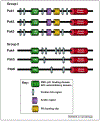An emerging role for p21-activated kinases (Paks) in viral infections
- PMID: 20071173
- PMCID: PMC6489496
- DOI: 10.1016/j.tcb.2009.12.005
An emerging role for p21-activated kinases (Paks) in viral infections
Abstract
p21-activated protein kinases (Paks) are cytosolic serine/threonine protein kinases that act as effectors for small (p21) GTPases of the Cdc42 and Rac families. It has long been established that Paks play a major role in a host of vital cellular functions such as proliferation, survival and motility, and abnormal Pak function is associated with a number of human diseases. Here, we discuss emerging evidence that these enzymes also play a major role in the entry, replication and spread of many important pathogenic human viruses, including HIV. Careful assessment of the potential role of Paks in antiviral immunity will be pivotal to evaluate thoroughly the potential of agents that inhibit Pak as a new class of anti-viral therapeutics.
Figures




References
-
- Radtke K et al. (2006) Viral interactions with the cytoskeleton: a hitchhiker’s guide to the cell. Cell Microbiol. 8, 387–400 - PubMed
-
- Manser E et al. (1994) A brain serine/threonine protein kinase activated by Cdc42 and Rac1. Nature 367, 40–46 - PubMed
-
- Pandey A et al. (2002) Cloning and characterization of PAK5, a novel member of mammalian p21-activated kinase-II subfamily that is predominantly expressed in brain. Oncogene 21, 3939–3948 - PubMed
-
- Jaffer ZM and Chernoff J (2002) p21-activated kinases: three more join the Pak. Int J. Biochem. Cell Biol. 34, 713–717 - PubMed
-
- Arias-Romero LE and Chernoff J (2008) A tale of two Paks. Biol Cell 100, 97–108 - PubMed
Publication types
MeSH terms
Substances
Grants and funding
LinkOut - more resources
Full Text Sources
Other Literature Sources
Medical
Miscellaneous

